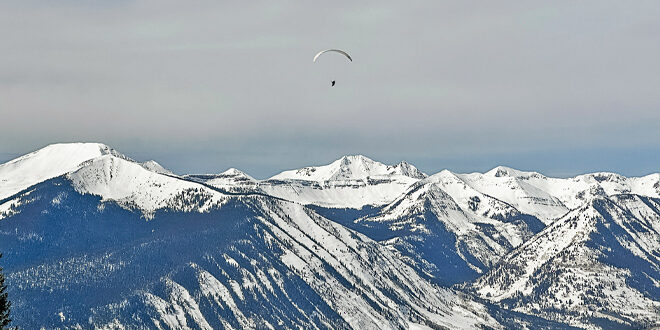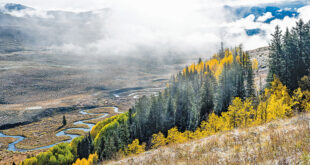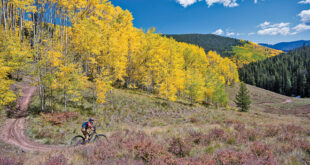Travel is good for so many reasons. It broadens the mind, changes perspective, exposes one to different cultures and can make you realize this valley is a small cog in a big world. It also made me think I need to make up for not writing much last week, so this editorial is pretty long (but it reads well) …
Maybe one of the biggest sleeper benefits of travel is the time to watch a lot of movies on long flights. One I got to watch was Barbie and, after reading the story in last week’s CB News about the town council wanting to dial up and crack down on parking to discourage cars in town, Barbie seemed in some ways the ideal dream world of some. The cars, snowmobiles, boats, camper vans and spaceships in Barbieland didn’t use fossil fuels. There was no congestion, and everyone got where they needed to be, including to the real world that was a bit more complicated than Barbieland. Barbie (all of them) and Ken (all of them) lived a good, uncomplicated life. It was all so simple… it seemed an ideal town council vision for Crested Butte that didn’t include carbon spewing, congesting cars. Life isn’t always that simple though.
Being over in Europe it was easy to see the benefits of their mass transit infrastructure system. Trains went everywhere. Every train ticket showed the amount of carbon I saved by taking the train. Talk about a Green Dream—I looked out the window of the train I was on at one point and saw a biker riding on a path with a windmill in the distance! I was in Barbieland! There were of course plenty of cars everywhere but using trains and buses was easy, especially between the towns with ski lifts.
It was, in some ways, the ultimate dream scenario for our North Valley. But to get there will require changing how we do things. It seems to me that easy and convenient are two keys to making successful change in human behavior. That would apply to anything, including a bigger shift to an already well-used mass transit system. The first impression of the town’s recent direction to clamp down further on parking in Crested Butte is that they are focused on the hard and the punishing. It was explained to me that part of the reason is to start putting pressure on the associated transportation partners like CBMR (good luck!), the local transit agencies (where the town is already well represented) and the county (One Valley!) to start the real work of providing transportation alternatives and “compel” them to do more. I would argue that more effort to “convince” the partners, especially in places where the town already sits on the board of directors, should be the priority instead of looking for ways to “compel” your partners to do something.
While Crested Butte’s long-term transportation plan cites the need for and encouragement of expanded buses and park-and-rides in the future, last week’s discussion didn’t. The vibe I get is that town staff and council don’t like vehicles and see them as a threat from a climate and livability perspective. Fair enough, and having fewer vehicles in town is a laudable long-term goal. But this isn’t Barbieland.
The new council direction also contained a financial element since the town is paying the out-of-county parking company about $60K annually to monitor and manage parking in CB. While the council responded to initial negative public feedback and expanded the grace period for parking on Sopris and Maroon Avenues to two hours, they lost money on that move and will go back to the one-hour grace period for side street parking. That limitation will also be expanded to other parts of town, starting around the bus stop near Sixth and Teocalli and the streets near the Four-Way Visitor’s Center parking lot. It appears that limitation will eventually be expanded to places like Whiterock and the Nordic Center area in the future as well. That will increase revenues through fines since people who park on the side streets for, say, a dinner experience, will likely not get back to their car in an hour so will get a ticket. Cha ching.
To me, the new direction seems to be missing that really important element—the idea of providing easy and convenient alternatives to encourage a change in behavior. Replacing the car with easy and convenient transportation infrastructure should be done in conjunction with the punitive actions, not as an aspirational goal after the crackdown is implemented. Local infrastructure is not currently in place to conveniently get rid of hundreds of more cars in CB. Will dialing up a parking crackdown compel everyone to come to the table to provide that or simply piss off everyone impacted by the moves? I’d bet on option B.
The RTA moves a ton of people between Gunnison, CB and Mt. CB and more people are using it every year. Success! But to eliminate a ton more car trips in the North Valley would mean upping the mass transit infrastructure that make the decision to use it easy and convenient. That likely means buying a bunch more buses, hiring a bunch more drivers, along with developing a bunch more park-and-rides up and down the valley. A FirstTracks sort of Uber-like alternative that has been super successful for north Mt. CB would be great as well. All of that is ideal but definitely not cheap. We’d all likely use mass transit more if we could count on a regular seat at times convenient to (the universal) us. I know I’ve waited and not been able to get on a full bus…so I drove. The easy, reliable and convenient infrastructure pieces should be the co-priority of council instead of just making a primary way workers and tourists use for coming to the hub of the North Valley, hard. Sounds like a tear in the space-time continuum between Barbieland and the real world.
Frankly, I really don’t get the effort to discourage parking near bus stops in town. The town seems offended that people park in town to grab the bus to the ski area in winter. That seems to be part of the ideal to me. People come in town, park in public parking spaces on public streets and ride the public bus instead of spewing more carbon to get to the parking lots at the ski area. The general idea of eliminating that option of parking near a bus stop is that it will push people to the school parking lot— which is a tough sell except in the busiest of times. Plus, school is in session during the ski season and while that idea could work on a busy Saturday for people willing to walk more than 500 feet to the closest bus stop (that’s another editorial), adding more cars to kids and congestion there doesn’t seem like a great idea.
Also, people who park-and-ride from town might stop at the grocery or the bar, a restaurant or the hardware store before heading home in a nearby subdivision. And while it might be irritating to feel the town is the provider of overflow ski parking that should be Vail’s responsibility, what would the town’s budget be between November and April if there wasn’t a ski area three miles up the road? Is it truly offensive and a hardship to help the North Valley’s main winter income generator and a source of great enjoyment for many of us by allowing public parking in public spots?
In the real world of Barbie, things are complicated. Same here. Vehicles are tools used to get from point A to point B. Sometimes that involves shuttling multiple kids from school to sports practice or art class. Sometimes it is dropping off packages to mail or transporting five bags of groceries. Occasionally it is taking a few laps in the morning when six inches of fresh comes in. People want to get their dogs to the shop and they aren’t allowed on RTA buses. Sometimes it is traveling from the rental house not located near a bus stop to get downtown to buy a meal or piece of art. Tin Cup Ice Cream and Desserts owner Matthew Price last month wrote a letter directed to the council expressing concern over limiting parking so much that it impacts the visitor experience that we all count on for our economy. Part of our “brand” is friendly (with some crust), easy and affordable. To ostracize that vehicle tool without a replacement tool seems short-sighted and frankly, exclusionary. While those living full-time or part-time near Crested Butte are not town residents, they still consider themselves part of the community.
My friends that live in town don’t use cars nearly as much as those of us that live outside of CB. That blessing is in place because the convenient infrastructure is in place. I would suggest expanding similar infrastructure to the rest of the community and then making it hard for your friends that live outside town and the tourists that fill the bank accounts. Then watch the number of cars dwindle in town.
Make it harder to get to the library, a Mountain Express bus stop and local businesses without providing good alternatives? This direction seems more in line with Kendom than Barbieland. CB isn’t Barbieland…yet. But it could eventually be closer to a simple ideal of fewer cars driving around CB with a direction that includes not just punishment but convenience and practical alternatives at the same time.
—Mark Reaman
 The Crested Butte News Serving the Gunnison Valley since 1999
The Crested Butte News Serving the Gunnison Valley since 1999






